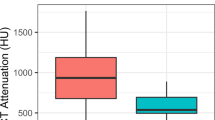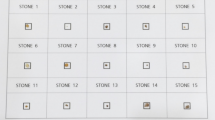Abstract
The efficiency and radiation dose of a low-dose dual-energy (DE) CT protocol for the evaluation of urinary calculus disease were evaluated. A low-dose dual-source DE-CT renal calculi protocol (140 kV, 46 mAs; 80 kV, 210 mAs) was derived from the single-energy (SE) CT protocol used in our institution for the detection of renal calculi (120 kV, 75 mAs). An Alderson-Rando phantom was equipped with thermoluminescence dosimeters and examined by CT with both protocols. The effective doses were calculated. Fifty-one patients with suspected or known urinary calculus disease underwent DE-CT. DE analysis was performed if calculi were detected using a dedicated software tool. Results were compared to chemical analysis after invasive calculus extraction. An effective dose of 3.43 mSv (male) and 5.30 mSv (female) was measured in the phantom for the DE protocol (vs. 3.17/4.57 mSv for the SE protocol). Urinary calculi were found in 34 patients; in 28 patients, calculi were removed and analyzed (23 patients with calcified calculi, three with uric acid calculi, one with 2,8-dihyxdroxyadenine-calculi, one patient with a mixed struvite calculus). DE analysis was able to distinguish between calcified and non-calcified calculi in all cases. In conclusion, dual-energy urinary calculus analysis is effective also with a low-dose protocol. The protocol tested in this study reliably identified calcified urinary calculi in vivo.


Similar content being viewed by others
References
Saita A, Bonaccorsi A, Motta M (2007) Stone composition: where do we stand. Urol Int 79 Suppl 1:16–19
Johnson CM, Wilson DM, O’Fallon WM et al (1979) Renal stone epidemiology: a 25-year study in Rochester, Minnesota. Kidney Int 16:624–631
Coll DM, Varanelli MJ, Smith RC (2002) Relationship of spontaneous passage of ureteral calculi to stone size and location as revealed by unenhanced helical CT. AJR Am J Roentgenol 178:101–103
Preminger GM, Tiselius HG, Assimos DG et al (2007) 2007 Guideline for the management of ureteral calculi. Eur Urol 52:1610–1631
Deveci S, Coskun M, Tekin MI et al (2004) Spiral computed tomography: role in determination of chemical compositions of pure and mixed urinary stones–an in vitro study. Urology 64:237–240
Heneghan JP, McGuire KA, Leder RA et al (2003) Helical CT for nephrolithiasis and ureterolithiasis: comparison of conventional and reduced radiation-dose techniques. Radiology 229:575–580
Kawashima A, Vrtiska TJ, LeRoy AJ et al (2004) CT urography. Radiographics 24 Suppl 1:S35–54 discussion S55-38
Kalra MK, Maher MM, D’Souza RV et al (2005) Detection of urinary tract stones at low-radiation-dose CT with z-axis automatic tube current modulation: phantom and clinical studies. Radiology 235:523–529
Mostafavi MR, Ernst RD, Saltzman B (1998) Accurate determination of chemical composition of urinary calculi by spiral computerized tomography. J Urol 159:673–675
Sheir KZ, Mansour O, Madbouly K et al (2005) Determination of the chemical composition of urinary calculi by noncontrast spiral computerized tomography. Urol Res 33:99–104
Motley G, Dalrymple N, Keesling C et al (2001) Hounsfield unit density in the determination of urinary stone composition. Urology 58:170–173
Mitcheson HD, Zamenhof RG, Bankoff MS et al (1983) Determination of the chemical composition of urinary calculi by computerized tomography. J Urol 130:814–819
Graser A, Johnson TR, Bader M et al (2008) Dual energy CT characterization of urinary calculi: initial in vitro and clinical experience. Invest Radiol 43:112–119
Grosjean R, Sauer B, Guerra RM et al (2008) Characterization of human renal stones with MDCT: advantage of dual energy and limitations due to respiratory motion. AJR Am J Roentgenol 190:720–728
Stolzmann P, Scheffel H, Rentsch K et al (2008) Dual-energy computed tomography for the differentiation of uric acid stones: ex vivo performance evaluation. Urol Res 36:133–138
Huda W, Sandison GA (1984) Estimation of mean organ doses in diagnostic radiology from Rando phantom measurements. Health Phys 47:463–467
Hunold P, Vogt FM, Schmermund A et al (2003) Radiation exposure during cardiac CT: effective doses at multi-detector row CT and electron-beam CT. Radiology 226:145–152
Zankl M, Panzer W, Drexler G (1991) The Calculation of Dose from External Photon Exposure Using Reference Human Phantoms and Monte Carlo Methods. Part VI: Organ Doses from Computed Tomographic Examinations. GSF-Bericht 30/91. GSF-Forschungszentrum für Umwelt und Gesundheit, Oberschleißheim
Protection ICoR (1991) Recommendation of the International Commission on Radiological Protection. ICRP Publication 60 Oxford. Pergamon Press
Poletti PA, Platon A, Rutschmann OT et al (2007) Low-dose versus standard-dose CT protocol in patients with clinically suspected renal colic. AJR Am J Roentgenol 188:927–933
Kim BS, Hwang IK, Choi YW et al (2005) Low-dose and standard-dose unenhanced helical computed tomography for the assessment of acute renal colic: prospective comparative study. Acta Radiol 46:756–763
Coe FL, Evan A, Worcester E (2005) Kidney stone disease. J Clin Invest 115:2598–2608
Author information
Authors and Affiliations
Corresponding author
Rights and permissions
About this article
Cite this article
Thomas, C., Patschan, O., Ketelsen, D. et al. Dual-energy CT for the characterization of urinary calculi: In vitro and in vivo evaluation of a low-dose scanning protocol. Eur Radiol 19, 1553–1559 (2009). https://doi.org/10.1007/s00330-009-1300-2
Received:
Revised:
Accepted:
Published:
Issue Date:
DOI: https://doi.org/10.1007/s00330-009-1300-2




